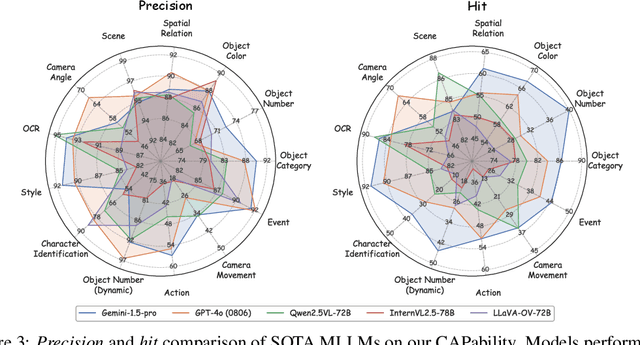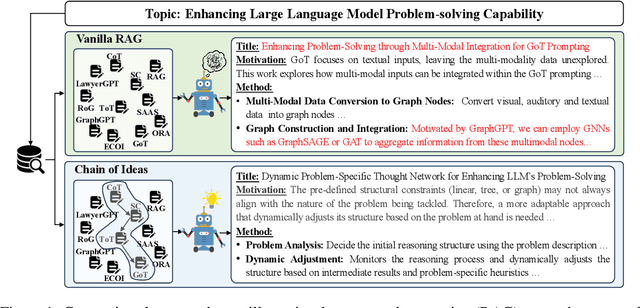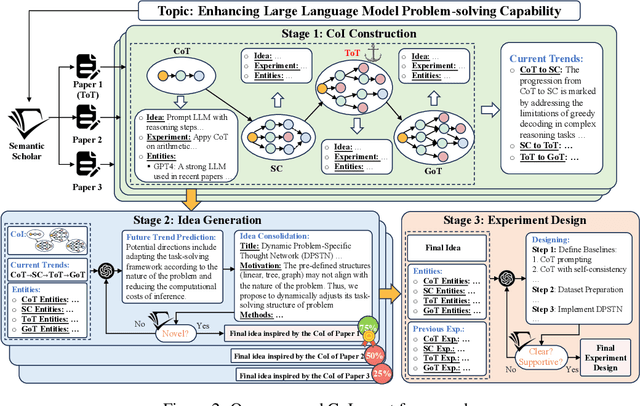Boqiang Zhang
What Is a Good Caption? A Comprehensive Visual Caption Benchmark for Evaluating Both Correctness and Coverage of MLLMs
Feb 19, 2025



Abstract:Recent advancements in Multimodal Large Language Models (MLLMs) have rendered traditional visual captioning benchmarks obsolete, as they primarily evaluate short descriptions with outdated metrics. While recent benchmarks address these limitations by decomposing captions into visual elements and adopting model-based evaluation, they remain incomplete-overlooking critical aspects, while providing vague, non-explanatory scores. To bridge this gap, we propose CV-CapBench, a Comprehensive Visual Caption Benchmark that systematically evaluates caption quality across 6 views and 13 dimensions. CV-CapBench introduces precision, recall, and hit rate metrics for each dimension, uniquely assessing both correctness and coverage. Experiments on leading MLLMs reveal significant capability gaps, particularly in dynamic and knowledge-intensive dimensions. These findings provide actionable insights for future research. The code and data will be released.
ECBench: Can Multi-modal Foundation Models Understand the Egocentric World? A Holistic Embodied Cognition Benchmark
Jan 09, 2025



Abstract:The enhancement of generalization in robots by large vision-language models (LVLMs) is increasingly evident. Therefore, the embodied cognitive abilities of LVLMs based on egocentric videos are of great interest. However, current datasets for embodied video question answering lack comprehensive and systematic evaluation frameworks. Critical embodied cognitive issues, such as robotic self-cognition, dynamic scene perception, and hallucination, are rarely addressed. To tackle these challenges, we propose ECBench, a high-quality benchmark designed to systematically evaluate the embodied cognitive abilities of LVLMs. ECBench features a diverse range of scene video sources, open and varied question formats, and 30 dimensions of embodied cognition. To ensure quality, balance, and high visual dependence, ECBench uses class-independent meticulous human annotation and multi-round question screening strategies. Additionally, we introduce ECEval, a comprehensive evaluation system that ensures the fairness and rationality of the indicators. Utilizing ECBench, we conduct extensive evaluations of proprietary, open-source, and task-specific LVLMs. ECBench is pivotal in advancing the embodied cognitive capabilities of LVLMs, laying a solid foundation for developing reliable core models for embodied agents. All data and code are available at https://github.com/Rh-Dang/ECBench.
VideoRefer Suite: Advancing Spatial-Temporal Object Understanding with Video LLM
Jan 08, 2025Abstract:Video Large Language Models (Video LLMs) have recently exhibited remarkable capabilities in general video understanding. However, they mainly focus on holistic comprehension and struggle with capturing fine-grained spatial and temporal details. Besides, the lack of high-quality object-level video instruction data and a comprehensive benchmark further hinders their advancements. To tackle these challenges, we introduce the VideoRefer Suite to empower Video LLM for finer-level spatial-temporal video understanding, i.e., enabling perception and reasoning on any objects throughout the video. Specially, we thoroughly develop VideoRefer Suite across three essential aspects: dataset, model, and benchmark. Firstly, we introduce a multi-agent data engine to meticulously curate a large-scale, high-quality object-level video instruction dataset, termed VideoRefer-700K. Next, we present the VideoRefer model, which equips a versatile spatial-temporal object encoder to capture precise regional and sequential representations. Finally, we meticulously create a VideoRefer-Bench to comprehensively assess the spatial-temporal understanding capability of a Video LLM, evaluating it across various aspects. Extensive experiments and analyses demonstrate that our VideoRefer model not only achieves promising performance on video referring benchmarks but also facilitates general video understanding capabilities.
Chain of Ideas: Revolutionizing Research Via Novel Idea Development with LLM Agents
Oct 25, 2024



Abstract:Effective research ideation is a critical step for scientific research. However, the exponential increase in scientific literature makes it challenging for researchers to stay current with recent advances and identify meaningful research directions. Recent developments in large language models~(LLMs) suggest a promising avenue for automating the generation of novel research ideas. However, existing methods for idea generation either trivially prompt LLMs or directly expose LLMs to extensive literature without indicating useful information. Inspired by the research process of human researchers, we propose a Chain-of-Ideas~(CoI) agent, an LLM-based agent that organizes relevant literature in a chain structure to effectively mirror the progressive development in a research domain. This organization facilitates LLMs to capture the current advancements in research, thereby enhancing their ideation capabilities. Furthermore, we propose Idea Arena, an evaluation protocol that can comprehensively evaluate idea generation methods from different perspectives, aligning closely with the preferences of human researchers. Experimental results indicate that the CoI agent consistently outperforms other methods and shows comparable quality as humans in research idea generation. Moreover, our CoI agent is budget-friendly, with a minimum cost of \$0.50 to generate a candidate idea and its corresponding experimental design.
Chain of Ideas: Revolutionizing Research in Novel Idea Development with LLM Agents
Oct 17, 2024



Abstract:Effective research ideation is a critical step for scientific research. However, the exponential increase in scientific literature makes it challenging for researchers to stay current with recent advances and identify meaningful research directions. Recent developments in large language models~(LLMs) suggest a promising avenue for automating the generation of novel research ideas. However, existing methods for idea generation either trivially prompt LLMs or directly expose LLMs to extensive literature without indicating useful information. Inspired by the research process of human researchers, we propose a Chain-of-Ideas~(CoI) agent, an LLM-based agent that organizes relevant literature in a chain structure to effectively mirror the progressive development in a research domain. This organization facilitates LLMs to capture the current advancements in research, thereby enhancing their ideation capabilities. Furthermore, we propose Idea Arena, an evaluation protocol that can comprehensively evaluate idea generation methods from different perspectives, aligning closely with the preferences of human researchers. Experimental results indicate that the CoI agent consistently outperforms other methods and shows comparable quality as humans in research idea generation. Moreover, our CoI agent is budget-friendly, with a minimum cost of \$0.50 to generate a candidate idea and its corresponding experimental design.
How Control Information Influences Multilingual Text Image Generation and Editing?
Jul 16, 2024Abstract:Visual text generation has significantly advanced through diffusion models aimed at producing images with readable and realistic text. Recent works primarily use a ControlNet-based framework, employing standard font text images to control diffusion models. Recognizing the critical role of control information in generating high-quality text, we investigate its influence from three perspectives: input encoding, role at different stages, and output features. Our findings reveal that: 1) Input control information has unique characteristics compared to conventional inputs like Canny edges and depth maps. 2) Control information plays distinct roles at different stages of the denoising process. 3) Output control features significantly differ from the base and skip features of the U-Net decoder in the frequency domain. Based on these insights, we propose TextGen, a novel framework designed to enhance generation quality by optimizing control information. We improve input and output features using Fourier analysis to emphasize relevant information and reduce noise. Additionally, we employ a two-stage generation framework to align the different roles of control information at different stages. Furthermore, we introduce an effective and lightweight dataset for training. Our method achieves state-of-the-art performance in both Chinese and English text generation. The code and dataset will be made available.
Focus on the Whole Character: Discriminative Character Modeling for Scene Text Recognition
Jul 08, 2024Abstract:Recently, scene text recognition (STR) models have shown significant performance improvements. However, existing models still encounter difficulties in recognizing challenging texts that involve factors such as severely distorted and perspective characters. These challenging texts mainly cause two problems: (1) Large Intra-Class Variance. (2) Small Inter-Class Variance. An extremely distorted character may prominently differ visually from other characters within the same category, while the variance between characters from different classes is relatively small. To address the above issues, we propose a novel method that enriches the character features to enhance the discriminability of characters. Firstly, we propose the Character-Aware Constraint Encoder (CACE) with multiple blocks stacked. CACE introduces a decay matrix in each block to explicitly guide the attention region for each token. By continuously employing the decay matrix, CACE enables tokens to perceive morphological information at the character level. Secondly, an Intra-Inter Consistency Loss (I^2CL) is introduced to consider intra-class compactness and inter-class separability at feature space. I^2CL improves the discriminative capability of features by learning a long-term memory unit for each character category. Trained with synthetic data, our model achieves state-of-the-art performance on common benchmarks (94.1% accuracy) and Union14M-Benchmark (61.6% accuracy). Code is available at https://github.com/bang123-box/CFE.
Self-Supervised Pre-training with Symmetric Superimposition Modeling for Scene Text Recognition
May 11, 2024



Abstract:In text recognition, self-supervised pre-training emerges as a good solution to reduce dependence on expansive annotated real data. Previous studies primarily focus on local visual representation by leveraging mask image modeling or sequence contrastive learning. However, they omit modeling the linguistic information in text images, which is crucial for recognizing text. To simultaneously capture local character features and linguistic information in visual space, we propose Symmetric Superimposition Modeling (SSM). The objective of SSM is to reconstruct the direction-specific pixel and feature signals from the symmetrically superimposed input. Specifically, we add the original image with its inverted views to create the symmetrically superimposed inputs. At the pixel level, we reconstruct the original and inverted images to capture character shapes and texture-level linguistic context. At the feature level, we reconstruct the feature of the same original image and inverted image with different augmentations to model the semantic-level linguistic context and the local character discrimination. In our design, we disrupt the character shape and linguistic rules. Consequently, the dual-level reconstruction facilitates understanding character shapes and linguistic information from the perspective of visual texture and feature semantics. Experiments on various text recognition benchmarks demonstrate the effectiveness and generality of SSM, with 4.1% average performance gains and 86.6% new state-of-the-art average word accuracy on Union14M benchmarks. The code is available at https://github.com/FaltingsA/SSM.
Choose What You Need: Disentangled Representation Learning for Scene Text Recognition, Removal and Editing
May 07, 2024Abstract:Scene text images contain not only style information (font, background) but also content information (character, texture). Different scene text tasks need different information, but previous representation learning methods use tightly coupled features for all tasks, resulting in sub-optimal performance. We propose a Disentangled Representation Learning framework (DARLING) aimed at disentangling these two types of features for improved adaptability in better addressing various downstream tasks (choose what you really need). Specifically, we synthesize a dataset of image pairs with identical style but different content. Based on the dataset, we decouple the two types of features by the supervision design. Clearly, we directly split the visual representation into style and content features, the content features are supervised by a text recognition loss, while an alignment loss aligns the style features in the image pairs. Then, style features are employed in reconstructing the counterpart image via an image decoder with a prompt that indicates the counterpart's content. Such an operation effectively decouples the features based on their distinctive properties. To the best of our knowledge, this is the first time in the field of scene text that disentangles the inherent properties of the text images. Our method achieves state-of-the-art performance in Scene Text Recognition, Removal, and Editing.
Symmetrical Linguistic Feature Distillation with CLIP for Scene Text Recognition
Oct 10, 2023Abstract:In this paper, we explore the potential of the Contrastive Language-Image Pretraining (CLIP) model in scene text recognition (STR), and establish a novel Symmetrical Linguistic Feature Distillation framework (named CLIP-OCR) to leverage both visual and linguistic knowledge in CLIP. Different from previous CLIP-based methods mainly considering feature generalization on visual encoding, we propose a symmetrical distillation strategy (SDS) that further captures the linguistic knowledge in the CLIP text encoder. By cascading the CLIP image encoder with the reversed CLIP text encoder, a symmetrical structure is built with an image-to-text feature flow that covers not only visual but also linguistic information for distillation.Benefiting from the natural alignment in CLIP, such guidance flow provides a progressive optimization objective from vision to language, which can supervise the STR feature forwarding process layer-by-layer.Besides, a new Linguistic Consistency Loss (LCL) is proposed to enhance the linguistic capability by considering second-order statistics during the optimization. Overall, CLIP-OCR is the first to design a smooth transition between image and text for the STR task.Extensive experiments demonstrate the effectiveness of CLIP-OCR with 93.8% average accuracy on six popular STR benchmarks.Code will be available at https://github.com/wzx99/CLIPOCR.
 Add to Chrome
Add to Chrome Add to Firefox
Add to Firefox Add to Edge
Add to Edge